News and Blog
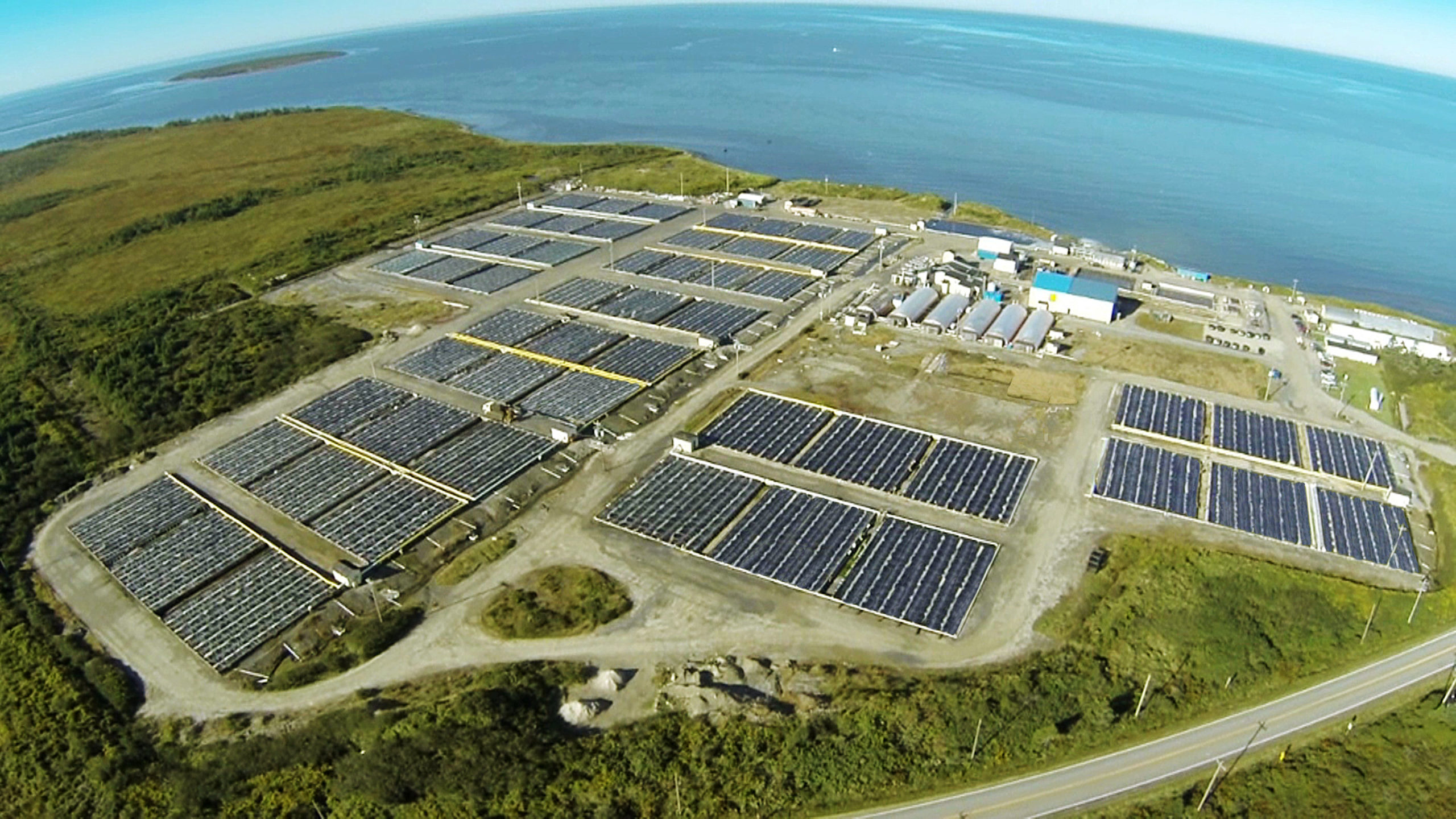
Pure Science, Hard Work & a Bit of Luck: How We Pioneered Land-Based Seaweed Cultivation
Did you ever ask yourself where edible seaweed originates from before it ends up on your plate? You’re probably imagining kelp forests swaying with the movements of the waves or colonies of merlot-colored algae fanning out from coastal rocks. Maybe you even have an assumption about which ocean it was grown in, whether in pristine Atlantic or Pacific waters. However, if you’ve ever eaten our tricolored seaweed, you may be surprised to learn that your food was grown completely on land in Nova Scotia.
The multicolored fronds that end up in each package of our Hana Tsunomata® edible seaweed began life in our land-based seaweed cultivation facility in Charlesville, NS. The first and largest of its kind, our on-land seaweed farming operation was not born overnight. Instead, the development of our seaweed food products required years of resilience, scientific exploration, hard-work and perfect timing.
Here’s the story of how we created a food product that customers throughout Asia now crave for its show-stopping display of color, reliable quality, satisfying texture and savory crunch—and how that story encapsulates what makes Acadian Seaplants Limited exceptional.
From Gathering to Growing Seaweed
The ability to grow seaweed on land is the result of accrued knowledge over hundreds of years. Though generations of coastal communities gathered wild seaweed for food, seaweed farming didn’t start until the 1670s when trailblazers in Tokyo Bay carefully placed tree branches and bamboo in shallow coastal waters to provide substrate for seaweed spores to attach and germinate. They didn’t yet understand the underlying science, but these observant farmers knew enough to dramatically increase their harvests of these nutritious crops.
Over time, Japanese farmers began to use horizontal nets instead of tree branches and bamboo to increase surface area available for spore attachment and to ease harvesting. Still the life cycles of these edible seaweeds were not completely known, resulting in low and unpredictable yields. Also, since the operations were located in coastal waters, the seaweed was exposed to multiple factors that can result in poor production and quality such as storms, overgrowth by other seaweeds, herbivory, and high inclusion rates of foreign material.
Not until 1949 when Kathleen Mary Drew-Baker, a famed English botanist, researched the reproduction cycles of Porphyra umbilicalis were scientists and farmers able to unlock the secrets of seaweed cultivation, and truly domesticate and commercialize its production. By understanding the full life cycle of Porphyra, Drew-Baker identified a microscopic life history phase (the conchocelis stage) that was previously thought to be a completely different species. Once the conchocelis was identified as the organism actually releasing spores that then grow into the crop farmers were after, this phase could itself be cultivated and induced to release massive amounts of spores on demand. This work allowed farmers to increase yields dramatically and made sea farming much more predictable.
In the 1970s, Marine Colloids, the forebearer to Acadian Seaplants Limited, built on the accumulated scientific seaweed knowledge to create a $1 million tank cultivation site in Charlesville to produce Chondrus crispus for carrageenan extraction. They were growing carrageenan-bearing seaweed that’s used as a food gum, but not a whole food, and as a seaweed ingredient it’s found in products such as toothpaste, jams, chocolate milk, salad dressings, ice cream, beer, health supplements, and cosmetics.
When our founder Louis Deveau—who had worked for Marine Colloids through their acquisition by FMC Corporation—offered to buy their Canadian seaweed operations and start his own company, he knew land-based seaweed cultivation had a future in Nova Scotia. Like all breakthroughs, new opportunities brought new challenges to overcome. Fortunately, our team was up to the task.
Solving the Puzzles of Seaweed Cultivation
Cultivating seaweed within land-based tanks is not a matter of simply putting seaweed in a tank and watching it grow. All seaweeds require light, nutrients, and seawater within the proper temperature range. When growing seaweeds on-land all of these factors can be manipulated to some extent, so the resulting on-land tank environment differs remarkably from nature. When done correctly, on-land cultivation can result in very high productivity, with seaweeds that are not subjected to stresses that are found in the wild such as competition with other seaweeds, destruction by herbivores, or low nutrient loads.
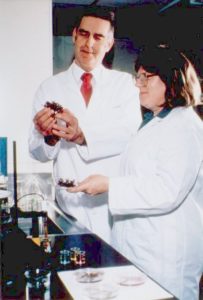
Dr. James S. Craigie
Dr. Jeff Hafting, Senior Scientist of Cultivated Seaweeds at Acadian Seaplants Limited, has been part of a long lineage of innovators who have explored ways to give Chondrus crispus and other seaweed cultivars what they require for high productivity.
“The approach at Acadian is letting the biology and the seaweed tell you if it’s happy,” said Dr. Hafting. “You make the systems fit the requirements of the seaweed, not the other way around.
We also look to differentiate our products from those of competitors, and our system allows us to grow natural variants of seaweeds that look completely different than wild types.” He and other members of the Charlesville team are carrying on the pure science and inventiveness pioneered by renowned seaweed researcher Dr. James S. Craigie. Jim’s involvement with ASL began with its founding in 1981 and has impacted every facet of the company’s scientific and technological growth. Very few scientists have made such a substantial contribution to the advancement of seaweed science and even fewer have coupled that science with applied programs that have resulted in innovative, environmentally sustainable commercial opportunities.
Cultivation Growing Pains
From the very beginning, our Charlesville team accepted there is always something new to learn when cultivating seaweed. An example is how the tank infrastructure evolved over time, in the early days Charlesville had 2,000 sq. meter raceways equipped with paddle wheels. These tanks were difficult to manage and when the wind would blow, most of the seaweed would end up on one side of the tank, leaving the other side empty. This increased light penetration on the empty side allowing other non-Chondrus seaweeds to grow on the surfaces of the tank. By subdividing the tanks into smaller units and by using aeration instead of paddlewheels, we were able to prevent both the clustering that reduces productivity and causes crop damage and reduce the growth of non-Chondrus seaweeds in the tanks. All the trial and error and innovation paid off, and by 1987, Charlesville had tripled its production of Chondrus crispus for the global carrageenan market. However, right at that time, a low-cost competitor emerged: red seaweed farmers in the Philippines.
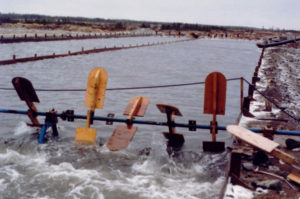
“The funniest thing is that Louis Deveau is one of the reasons why the carrageenan industry took off in the Philippines,” said Dr. Hafting. “In the ‘60s and ‘70s, he was brought in by Marine Colloids to improve cultivation of a tropical red seaweed and stabilize their supply from the Philippines. His work was a success for the local communities where he helped to achieve self-reliance and sustainability, but he also set the stage for these lower-cost cultivated seaweeds to eventually out-compete on-land cultivation for carrageenan ten years later.”
The innovation that began with Dr. Craigie’s early science achievements has continued to this day. Dr. Hafting leads a diverse research team developing seaweed products from newly domesticated species, optimizing seaweed production, and integrating new technologies. “One of the largest challenges with growing seaweed in large outdoor tanks was that other weeds could sprout, just like in a terrestrial garden,” explained Hafting. An intense research effort was mounted, lasting just under two years, that involved the optimization of nutrient loading in the tanks, so that only the nutrients that Chondrus required were added with no excess that other seaweeds could use to grow. Also, a number of water sanitization methods were developed, and the Chondrus is now grown in a 100% epiphyte-free culture, a first in seaweed cultivation! This also allows overwintering of pure Chondrus and its grow-out in the spring, resulting in greatly enhanced seasonal production. Another recent R&D achievement involves monitoring the seaweed cultivation tanks from above with a drone-mounted, near infrared camera to look for patterns of poor distribution within the tanks. This results in very high productivity as conditions can be monitored and corrected quickly.
Pioneering a Premier Sea Food Product
As we struggled in the low-price carrageenan market, Louis Deveau happened upon another opportunity. While at the 13th International Seaweed Symposium in Vancouver, Louis met Junichi Sato, the Director of Seaweed Development at Riken Food Co., who was in search of a premium seaweed (sea food) product. Mr. Sato asked Louis if we could grow food-grade Chondrus at Charlesville. Confident in the ingenuity of his people, Louis said yes!
Though we eventually created our beloved Hana Tsunomata® products, the entire process required the combination of pure science, hard work, and plain luck.
“In the wild, Chondrus crispus is as hard as nails. Nobody eats it, because it would break your teeth if you tried to chew it,” said Dr. Hafting. “The Chondrus that we’re growing now for Hana Tsunomata® was an oddball. It grows very rapidly, tastes great, and has an excellent texture with a bit of a crunch to it. It’s those sorts of things we figure out with observation and experimentation.”
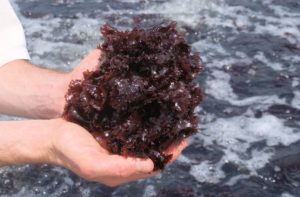
The whole process required Charlesville to embrace their creativity and nature’s unpredictability. Dr. James Craigie encouraged the team to play around with the Irish moss, practicing “pure science conducted on the basis of curiosity and experimentation” to unlock the secrets of Chondrus crispus. Under Dr. Craigie’s guidance we worked with scientists from Canada’s National Research Council (NRC) and at the same time, the Atlantic Canada Opportunities Agency (ACOA) helped us accelerate our research into food-grade Chondrus. We designed every piece of equipment from scratch. Since there was no model to follow we developed innovative dry line and extraction processes not seen anywhere in the world. Quality improved, but we still struggled with key aesthetics so important to the Asian food market.
Customers in the Japanese market wanted a vivid red seaweed that not only tasted good but looked beautiful, uniform, and pristine. Each fanning frond needed to have the right number of branches and a consistently-shaped tail. Seaweed doesn’t grow like that in nature. Fortunately, people like our own Allan Archibald, and former employees Vel Pillay and Steve Spinney, brainstormed a brilliant idea to achieve that goal. Rather than continuously cultivating the same seaweed stock from outdoor tanks year after year, we started anew with a cutting each year, a unialgal starting point, which allowed for entire crops of uniform and clean seaweed!
Today, we’ve perfected the system. Our annual crop starts as a single thumbnail sized piece of seaweed in a lab in Cornwallis, NS. Then, we cultivate the seaweed, bringing it through as many as 40 doublings in mass to get to over a million kilograms at the end of the growing season. As each year’s crop progresses through our cultivation facilities, we transition the plants to larger and larger indoor containers (one so large that a greenhouse fits over it) until they’re ready for our outdoor tanks after the winter ice has ended for the season.
Staying Open to Inspiration
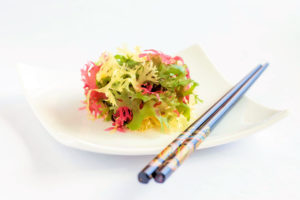 One of the most unexpected innovations with our edible Hana Tsunomata® seaweed came in the form of the vivid tricolors. At the outset of working with Mr. Sato, we knew that customers wanted a seaweed with a specific pink hue to it. How do you accentuate the pigment in a red seaweed that appears almost brownish in the wild? It’s all about extraction.
One of the most unexpected innovations with our edible Hana Tsunomata® seaweed came in the form of the vivid tricolors. At the outset of working with Mr. Sato, we knew that customers wanted a seaweed with a specific pink hue to it. How do you accentuate the pigment in a red seaweed that appears almost brownish in the wild? It’s all about extraction.
“We selectively extract pigments. Much like a leaf changes colors in the fall, we realized that we simply needed to unmask those pigments, extracting the green out of it for the pink to show through,” said Dr. Hafting. “As we were doing that work, we realized we could remove the pink and then have a green plant. Now we had two colors in our product line. During that extraction process, one of the researchers made a mistake, leaving the experiment over the weekend, only to return Monday to find samples that were bright yellow. It was serendipitous and gave us our unique yellow product.”
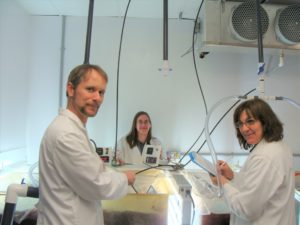
Dr. Jeff Hafting, Kerry Leavitt and Lynn Cornish
Though our Hana Tsunomata® led the way, we’re not done innovating. Right now, Dr. Hafting and his team are in the process of exploring a variety of other seaweeds for their various potential.
“Because we’re on land in our labs, we see these morphological variations that occur naturally in the wild; but would have remained hidden under the surface ace of the water,” said Dr. Hafting. “We grab these oddballs, stick them in a container, clean them up, and end up with something that nobody else has. Sometimes these variants can look completely different from the wild type, and are therefore available only from Acadian Seaplants, giving us a unique market differentiation. Often, these variants can be very different and interesting from a biochemical point of view and may lead to the development of new products based on bioactivity.”
This just goes to show that science isn’t always a story of immediate answers or A to B exploration. It’s a matter of timing, creativity, methodology and a willingness to embrace the unexpected breakthroughs that can occur when scientists are encouraged to explore. When you do, there’s no end to the incredible innovations that can end up on your plate.
Want to learn more about how our land-based seaweed cultivation creates quality products? You can learn about our Hana Tsunomata ® or about our research and development.
Related Articles
Automation with a Human Touch: How Acadian Seaplants Balances Technology and People
How ASL Keeps Improving Our Seaweed Resource Assessments
How ASL Contributes to the Zero Hunger Project by Boosting Plant Health
